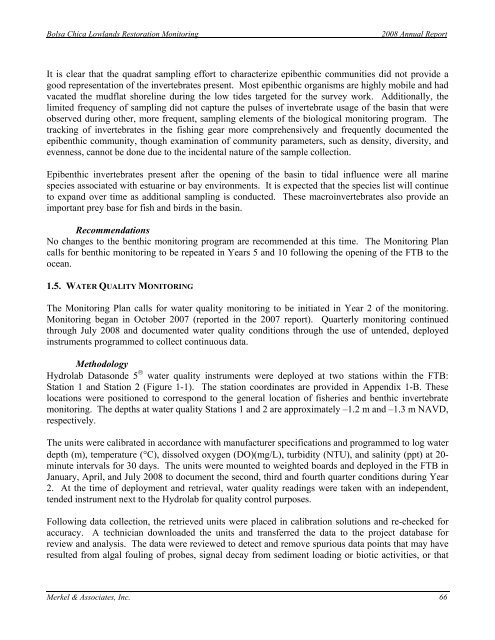2008 Annual Monitoring Report (pdf 10.9MB) - Bolsa Chica ...
2008 Annual Monitoring Report (pdf 10.9MB) - Bolsa Chica ...
2008 Annual Monitoring Report (pdf 10.9MB) - Bolsa Chica ...
You also want an ePaper? Increase the reach of your titles
YUMPU automatically turns print PDFs into web optimized ePapers that Google loves.
<strong>Bolsa</strong> <strong>Chica</strong> Lowlands Restoration <strong>Monitoring</strong><br />
<strong>2008</strong> <strong>Annual</strong> <strong>Report</strong><br />
It is clear that the quadrat sampling effort to characterize epibenthic communities did not provide a<br />
good representation of the invertebrates present. Most epibenthic organisms are highly mobile and had<br />
vacated the mudflat shoreline during the low tides targeted for the survey work. Additionally, the<br />
limited frequency of sampling did not capture the pulses of invertebrate usage of the basin that were<br />
observed during other, more frequent, sampling elements of the biological monitoring program. The<br />
tracking of invertebrates in the fishing gear more comprehensively and frequently documented the<br />
epibenthic community, though examination of community parameters, such as density, diversity, and<br />
evenness, cannot be done due to the incidental nature of the sample collection.<br />
Epibenthic invertebrates present after the opening of the basin to tidal influence were all marine<br />
species associated with estuarine or bay environments. It is expected that the species list will continue<br />
to expand over time as additional sampling is conducted. These macroinvertebrates also provide an<br />
important prey base for fish and birds in the basin.<br />
Recommendations<br />
No changes to the benthic monitoring program are recommended at this time. The <strong>Monitoring</strong> Plan<br />
calls for benthic monitoring to be repeated in Years 5 and 10 following the opening of the FTB to the<br />
ocean.<br />
1.5. WATER QUALITY MONITORING<br />
The <strong>Monitoring</strong> Plan calls for water quality monitoring to be initiated in Year 2 of the monitoring.<br />
<strong>Monitoring</strong> began in October 2007 (reported in the 2007 report). Quarterly monitoring continued<br />
through July <strong>2008</strong> and documented water quality conditions through the use of untended, deployed<br />
instruments programmed to collect continuous data.<br />
Methodology<br />
Hydrolab Datasonde 5 ® water quality instruments were deployed at two stations within the FTB:<br />
Station 1 and Station 2 (Figure 1-1). The station coordinates are provided in Appendix 1-B. These<br />
locations were positioned to correspond to the general location of fisheries and benthic invertebrate<br />
monitoring. The depths at water quality Stations 1 and 2 are approximately –1.2 m and –1.3 m NAVD,<br />
respectively.<br />
The units were calibrated in accordance with manufacturer specifications and programmed to log water<br />
depth (m), temperature (°C), dissolved oxygen (DO)(mg/L), turbidity (NTU), and salinity (ppt) at 20-<br />
minute intervals for 30 days. The units were mounted to weighted boards and deployed in the FTB in<br />
January, April, and July <strong>2008</strong> to document the second, third and fourth quarter conditions during Year<br />
2. At the time of deployment and retrieval, water quality readings were taken with an independent,<br />
tended instrument next to the Hydrolab for quality control purposes.<br />
Following data collection, the retrieved units were placed in calibration solutions and re-checked for<br />
accuracy. A technician downloaded the units and transferred the data to the project database for<br />
review and analysis. The data were reviewed to detect and remove spurious data points that may have<br />
resulted from algal fouling of probes, signal decay from sediment loading or biotic activities, or that<br />
Merkel & Associates, Inc. 66






